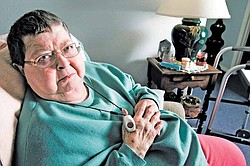Small changes help keep elderly in their homes
MCT
Shirley Saathoff uses a small panic-button pendant and two-way communication system for her tidy Lee's Summit home. "It's a godsend, honey," said the 72-year-old woman of the device that provides 24-hour monitoring.
McClatchy Newspapers
KANSAS CITY, Mo
Replace doorknobs with levers. Widen door frames. Install a ramp over the front stoop. And maybe add a few electronic monitoring gizmos.
Those are solutions that help the elderly — especially those with physical challenges — stay in their longtime homes.
“Aging in place” is what the lion’s share of older Americans want. But in single-family houses, that can be hard to do.
So some aging residents move into a widening array of senior housing projects.
Others are getting by with something as simple as a new toilet — just a few inches higher — and some grab-bars in the bathroom. That’s what it took to make it easier and safer for one elderly man to use his bathroom again.
“Sometimes I want to cry when I see how some older people are struggling,” said Clay McQuerry, a certified aging-in-place specialist at Missouri nonprofit Rebuilding Together Clay County, who visited the man.
Whether it’s remodeling a room or signing up for a panic button to press after falling, a growing and ever-more- advanced array of “universal design” and “assistive technology” features are available for aging homeowners.
Demand will skyrocket as the over-65 population booms. Futurists say elderly or infirm people living in their own homes may even have monitoring equipment that, using artificial intelligence, won’t just respond to but will help predict when emergencies might occur.
“There are so many little things we can do, so many new assistive devices that are being created to help people stay in their homes,” McQuerry said. “We just have to know about them.”
For now, fancy technology takes a back seat to remodeling and some basic call devices.
Shirley Saathoff, for example, got a small panic-button pendant and two-way communication system for her tidy Lee’s Summit, Mo., home.
“It’s a godsend, honey,” said the 72-year-old woman of the device that provides 24-hour monitoring. “I’ve fallen five times, and there was no one around to tell I’d fallen.”
Frankie Cline, 87, got new front steps and a railing at her Clay County front door, replacing a single, very tall step. She used to have to hold onto a chair on the step to get up it, but twice the chair slipped, and she fell.
“I feel like I’m living again,” Cline said. “And my friends — they’re getting old, too — can visit again. Before, they couldn’t get in my house, either.”
In Lee’s Summit, an 83-year-old retired autoworker and his wife can keep their washer and dryer in their basement, thanks to a chair lift on the stairs.
Like many older people interviewed, the couple cited privacy and security worries and requested that their names not be published. But they were happy to show their renovated bathroom, featuring a flat- entry shower stall with a seat and an adjustable shower head.
“Our intention is to stay here,” the man said.
Saathoff entered the world of assistive technology after spending hours on the floor, her body twisted awkwardly, unable to reach her telephone just a yard away.
Yet she remains adamant: “I don’t want to go to a nursing home. I love my home.”
But like most aging Americans, she can’t stay in her familiar, private surroundings without help.
Once a baker who spent hours on her feet, Saathoff now can barely get into her tiny kitchen. Her walker, which she needs to move around, doesn’t fit. So, slowly and unsteadily, she parks the walker and leans heavily on a chair, then the counter to spend a few minutes preparing a meal.
With limited mobility because of health issues, Saathoff has been in and out of the hospital several times but says: “I won’t give up. I do what I have to do to stay at home.”
For her that means frequent visits from her daughter — “my angel” — who shops for her. Sadly, it means that her car has been parked, perhaps permanently, since last summer.
Saathoff pays $34.95 a month to lease the panic-button service, which includes a two-way communication unit smaller than a cereal box. It sits next to her phone on a small table in her living room.
Her Home for Life Solutions equipment, monitored 24/7 through a call center managed by John Knox Village, is sensitive enough to pick up her voice from anywhere in her one-bedroom apartment if it’s activated by a push of her pendant button.
“I push it, and they call me through the box,” Saathoff said. “I answer, and they hear that I’m OK — or I don’t answer, and they send the paramedics.”
Copyright 2011 Associated Press. All rights reserved. This material may not be published, broadcast, rewritten, or redistributed.
 43
43

